Midland Pullman Lighting
This was the second train I added lighting to. As for the APT, I installed head and tail lights, a cab light at each end, and interior lighting to the passenger vehicles. However, as it is a much shorter train, the total load is within the capacity of the motor decoders at each end.
The Midland and Western Pullman sets were fitted with twin headlamps and a single, central tail light. These were covered by Nanking Blue blanking disks to hide the unwanted aspects according to the direction of travel. The twin headlamps were a direct implementation of the standard class 1 express passenger train headlamp code as used on steam engines since before nationalisation. The Western Region refused to allow the in-built tail lamp to be used for quite a few years, insisting on a regulation oil lamp being placed on one of the lamp brackets. But then the Western Region always did things their own way! I believe that the London Midland Region accepted Metropolitan-Cammell’s intentions from the outset and my model is lit accordingly.
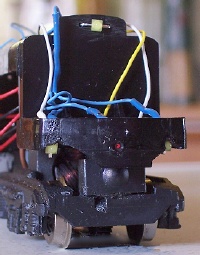 The first task was to drill out the mouldings for the three lamps and to find out what was behind them, so that I could work out how I might mount the LEDs. The front skirt of the underframe coincided with these, so it soon became clear that the LEDs would have to be mounted on this moulding, which gave the immediate advantage of simplifying the wiring. There was very limited clearance to the back of the skirt, so I needed to use the DCCconcepts micro-dot LEDs. Light is conducted through the bodywork by 2mm diameter clear polystyrene stalks cut from the back of the APT lenses.
The first task was to drill out the mouldings for the three lamps and to find out what was behind them, so that I could work out how I might mount the LEDs. The front skirt of the underframe coincided with these, so it soon became clear that the LEDs would have to be mounted on this moulding, which gave the immediate advantage of simplifying the wiring. There was very limited clearance to the back of the skirt, so I needed to use the DCCconcepts micro-dot LEDs. Light is conducted through the bodywork by 2mm diameter clear polystyrene stalks cut from the back of the APT lenses.
The picture here shows the LEDs installed behind the underframe skirt. Testing showed that I will need to obscure the back and underside of the LEDs to prevent light leaking onto the track!
The cab light was simply glued to the back wall of the cab.
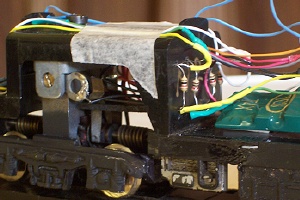 The resistors for the LEDs were all mounted on the back wall of the motor bogie housing. As shown in the picture, their leads were shaped to provide a stand-off to avoid heat damage to the plastic. The tape over the top of the motor housing bridge is to retain the wiring in place.
The resistors for the LEDs were all mounted on the back wall of the motor bogie housing. As shown in the picture, their leads were shaped to provide a stand-off to avoid heat damage to the plastic. The tape over the top of the motor housing bridge is to retain the wiring in place.
The passenger interior lighting was assembled on strip board in much the same way as for the APT. These again were series pairs of DCCconcepts daylight white micro-dot LEDs, since I believe the originals were lit by modern fluorescent tubes.
The red and black wires visible here are to additional pickups I fitted to the trailing bogie of the power car. |
|
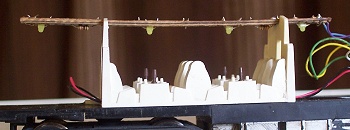 |
 |
|
I attached the lighting strip to the inside of the body-shell to make it easier to connect the jumpers to the next car. I have used a polarised crimp connector (the header plug can be seen on the right of the picture here) to allow for future dismantling.
Each power car is electrically connected to the adjacent kitchen car and parlour car to provide interior lighting. There is no electrical connection between the two parlour cars, each half is independent.
|
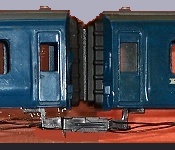 |
|
I did consider using the Roco 4-pole couplings for the inter-car electrical connections but decided that they were much too pricey.
The picture on the left is of a trial fitting of a Roco 4-pole coupling in a Keen Close Coupling adaptor.
... whilst the picture on the right shows my final solution with with active jumpers and Keen’s scale buckeye couplings fitted. |
|
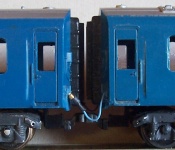 |
Configuring the Decoders
Both power cars have TCS T4X four-function decoders fitted, these are configured to the same address but with different IDs set for locking. The white and yellow wires from each decoder are used as intended for the head and tail lights of its own vehicle, the other two functions control the cab and interior lighting for its half of the train.
The following CVs are amended in each half set to achieve the lighting functions I wanted:
| CV | Value | Result | Output |
|---|
| 35 | 4 or 8 | Green wire to F1 (default) or F2 | Driver’s cab lights |
| 36 | 16 | Purple wire to F3 | Passenger coach lighting |
Footnote: DCCconcepts is an Australian firm but their products are available in the UK from Bromsgrove Models to whom I am unrelated save as a very satisfied customer.
• Back to previous page
 The first task was to drill out the mouldings for the three lamps and to find out what was behind them, so that I could work out how I might mount the LEDs. The front skirt of the underframe coincided with these, so it soon became clear that the LEDs would have to be mounted on this moulding, which gave the immediate advantage of simplifying the wiring. There was very limited clearance to the back of the skirt, so I needed to use the DCCconcepts micro-dot LEDs. Light is conducted through the bodywork by 2mm diameter clear polystyrene stalks cut from the back of the APT lenses.
The first task was to drill out the mouldings for the three lamps and to find out what was behind them, so that I could work out how I might mount the LEDs. The front skirt of the underframe coincided with these, so it soon became clear that the LEDs would have to be mounted on this moulding, which gave the immediate advantage of simplifying the wiring. There was very limited clearance to the back of the skirt, so I needed to use the DCCconcepts micro-dot LEDs. Light is conducted through the bodywork by 2mm diameter clear polystyrene stalks cut from the back of the APT lenses. The resistors for the LEDs were all mounted on the back wall of the motor bogie housing. As shown in the picture, their leads were shaped to provide a stand-off to avoid heat damage to the plastic. The tape over the top of the motor housing bridge is to retain the wiring in place.
The resistors for the LEDs were all mounted on the back wall of the motor bogie housing. As shown in the picture, their leads were shaped to provide a stand-off to avoid heat damage to the plastic. The tape over the top of the motor housing bridge is to retain the wiring in place.


